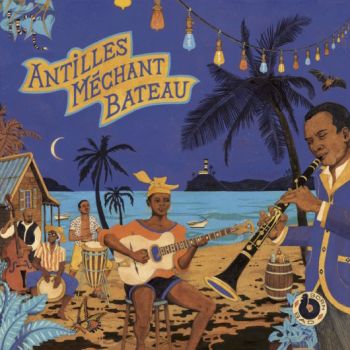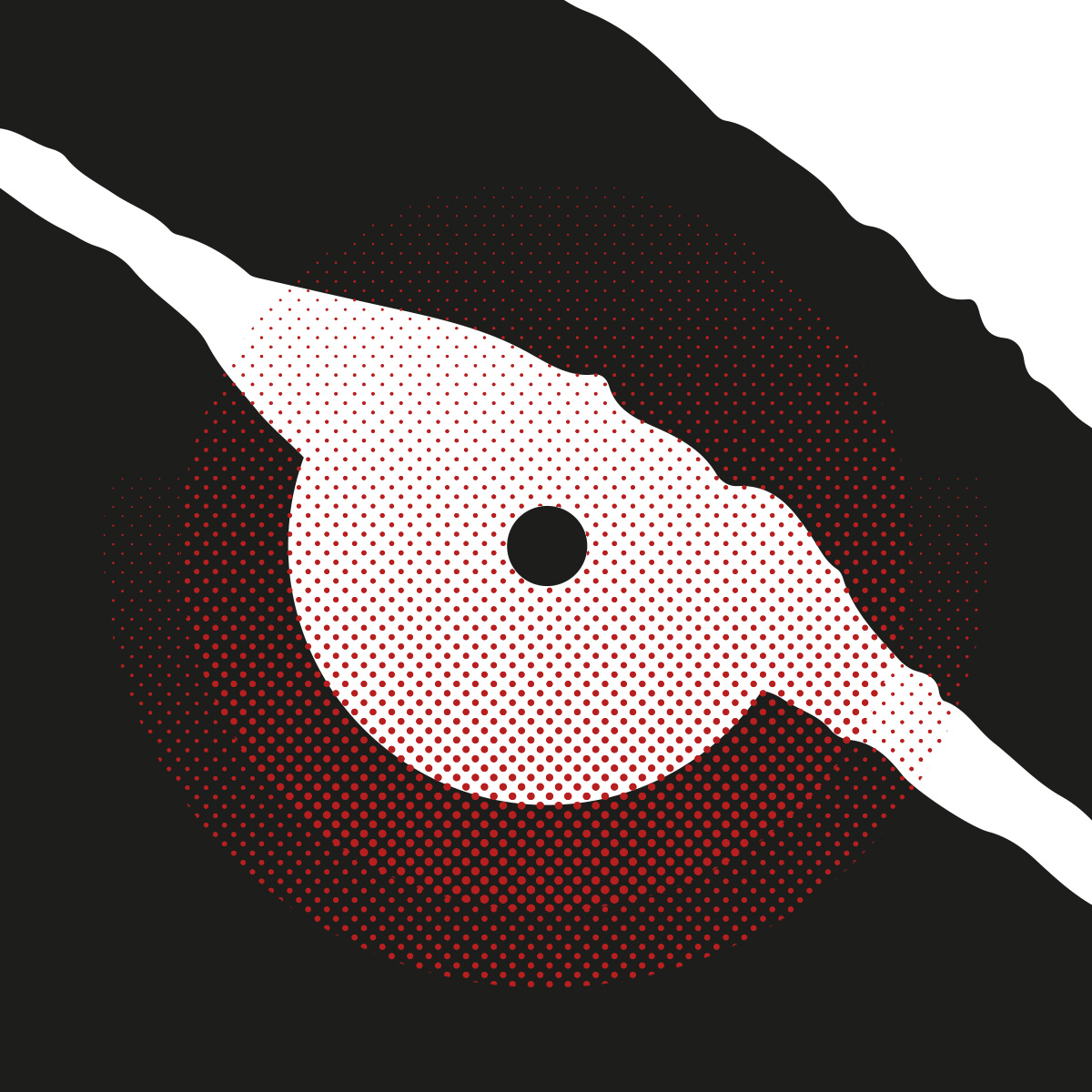
Born Bad
v/a- ANTILLES MECHANT BATEAU - DEEP BIGUINES & GWO KA FROM '60s FRENCH WEST INDIES LP
Includes d/l code.
4-pg booklet with English and French liner notes.
The West Indies – a sweet coastline subject to many clichés from another time. That postcard with coconut trees, a glass of rum to sip on, those so exotic madras dresses… Almost as many as in Compagnie Créole’s “doudouist” songs, that say a lot about the misunderstandings from both sides of the ocean. West Indians are still as stuck with this distorted outlook as in the good old days of the colonies. Because, underneath the veneer of moldy images, a completely different reality is woven. ‘They beat drums but were never number one’ – to misquote the chorus by a Martinique-born French singer. This is the subject of this collection – musicians drumming on percussion as a way of asserting their creolized identity. Songs that tell, in veiled terms, a different reality from what mainlanders were fed with. Special cases, with cries of joy and laments accompanied by cadences, as an invitation to trance, all immersed in the Caribbean melting pot of rhythm.
“’Antilles’ Méchant Bateau”, a low-tempo number with a bolero feel, indeed a pure case of the blues, and a terrific saxophone solo. What else would you expect to set the tone for this selection, in which beguine regains its original colors, in the darkness of the gwo ka drums. This 45 by André Mahy, released under the Aux Ondes sublabel, was recorded in the 1960s at Célini’s, one of Guadeloupe’s two main houses. Through its drum rolls and harrowing chant, it recalled how, long before the mid-1960s, the Antilles’ history was written in an ocean of teardrops – namely the Black Atlantic, as so rightly put by Martinician philosopher and poet Edouard Glissant in L’Archipel des Grands Chaos.
These “cursed boats” – slavers – carried millions of Africans to the American continent for centuries. All this sinister story had begun with the landing of a fleet of caravels steered by Christopher Columbus in 1492. It was the first step towards a colonization that was about to decimate the indigenous peoples of this terra incognita and deport the vital spark from the cradle continent of humankind. A year later, on November 4th, 1493, the same Colombus christened Guadeloupe after the Royal Monastery of Santa María de Guadalupe in Extremadura. The cross – a booming symbol – was there to justify the ordeal of peoples to whom even humanness was denied. Soon, once the Caribbean tribes were eradicated, the French would massively import workforce from Ghana, Togo, Dahomey, Ivory Coast, Nigeria, Cameroon, Gabon, Congo or Angola, as recalled by the Marches dedicated to the various ethnicities of slaves in 2012, which faced the Memorial of the ka drum on the Grande-Terre island in Guadeloupe.
Hundreds of thousands of them would have to survive the nightmare of plantations, comparable to the plantation system in the American South: chains, leg irons, shackles, fetters, garottes, iron collars and branks, dungeons or lynchings set the tempo of everyday life. The sugar aristocracy (the brown gold of the time) set a reign of terror on plantations. The masters had full powers, including life and death, over the slaves who worked from four in the morning to sunset… until April 27th, 1848 – date of the second and definitive abolition of slavery thanks to the struggle of Victor Schœlcher, an MP who was close to Lamartine (the first one had been pronounced in the wake of the French Revolution, but soon repressed in blood by Bonaparte…). However, the path would still be long to see the newly-born Republic’s motto applied: Liberty, Equality, Fraternity … The “post-slavery” society would perpetuate real economic segregation – a distinction that would be reproduced from generation to generation… And even if, a century later, the law of 19th March 1946 granted the four old colonies the status of Overseas Departments, nothing changed in the course of history. This gap would then widen, differently but surely, as the Republic implemented an assimilation policy that would deny identities and make a clean break with the past.
In this fool’s game, the ka became, in the 1960s, the voice of identity for Guadeloupeans who couldn’t resolve being purely and solely disintegrated. Made from salting or wine barrels from the colonial era – boats keep coming back in this ebb and flow movement – the “quarter”, or “ka” once creolized, was a powerful symbol of resistance since the colonial era. Even if its practice was quickly proscribed by masters, considering it contained the seeds of revolt, this great drum (long known as a ‘bamboula’, which means ‘pagan festival’ in Haiti, and became a popular expression in De Gaulle’s France) inexorably wormed its way into the local culture, until becoming the essential melting pot for the movement of ‘root music’ against mainland France’s deaf hear. Or its beating heart, following the seven specific rhythms of gwo ka.
More than just a matter of rhythms, this drum carried a speech full of history and stories, a message of memories and hopes. The gwo ka bore the stigmata of a slave society, from which all its associated chants were inherited. A medium of the voiceless, this drum would act like an ointment on mistreated bodies, but also as a stimulant for rebellious souls. Under the drummer’s fingers, the ka drummed up the ancestors’ spirits. Just like words convey the memory of a people that was long demoted to the status of a simple item of personal property – according to article 44 of the 1685 Code Noir draught by Colbert to regulate the status of slaves – before being governed by a system of identification booklets allowing to monitor the movements and work of the workforce in a Guadeloupe admittedly liberated from slavery, but still looking like a “banana” regime. This trauma appears through a repertoire that reflects the pain of cane cutters and the euphoria of pay day, the oppression of racism and the recourse to the myth of a promised land. Songs burst with all the bestiary that populates the countryside and the many fish that feed stews, acid satires on the daily reality and apposite witticisms on international events, chronicles anchored in the local soil as well as biting plays on words. One may sing to keep vigil over a dead person, or launch into long, saucy tirades at a bibulous party.
At the turn of the 1960s, while some bars were still for whites only, while speaking Creole was forbidden in schoolyards, while drum music was considered a “mizik vié neg” (“old negro music”), while the church saw a symbol of degeneration in it, the Maroon spirit – from the name of the slaves who fled plantations to live free in the woods – rose from its depths, in another form. In this decade and the one that followed, this movement, that gave its place back to percussion, accompanied more precise claims as English-speaking islands gained independence. By playing the ka (which was banned from official studios), one actually chose their side. From 1963, the freshly-instituted Bumidom (Office for Overseas Migration) organized a strong West-Indian emigration towards low-skilled jobs and a dull suburban life. In response, the Gong (group for Guadeloupe’s National Organization) called for Guadeloupe’s independence, and two years later, the Guadeloupean Front for Autonomy appeared. Those years were punctuated by strikes and repressions, culminating in May 1967 with a real massacre in the public square in Pointe-à-Pitre, the toll of which would not be disclosed until 2012. Many would denounce the bloodbath operated by the Bumidom among Guadeloupe’s lifeblood. Slogans flourished on walls, including the iconic: Jeune, ne quitte pas ton pays (“Young people, do not leave your country”).
Part of the youth got the message, choosing to take the drum back in hand as a symbol of the emasculated identity of this “entirely apart” people, to quote Aimé Césaire, the father of Negritude. The ka became the soundtrack of this generation, who sped up the tempo with the 70s and definitely transplanted it to town, while the plantation economy – the original soil of the ka drum – was in crisis. From then on, the old tambouyés (drummers) finally went celebrated as they should be: Anzala, Carnot, Serge Dolor, Ti Seles, Robert Loyson, Arthème Boisban, Esnard Boisdur … and especially Velo – born Marcel Lollia – who nevertheless died in misery, in the street, in 1984. “Champs de canne, champs de coton !” (“Cane fields, cotton fields!) Guy Konket roared, one of the great champions of the Guadeloupean cause, whose path followed on from this legacy, moving it onto the asphalt of Carénages, Pointe-à-Pitre’s hot district. The poet sure had a good turn of phrase, that hit the spot just like his mouth drum.
No doubt, blues and ka fought the same battle – centuries of oppression, of negation, before finding the path to possible redemption. Between them, the same language – the language of the Creole spirits, flooded in the great ocean. This is what this selection is about, and its good, inborn sense of humor shouldn’t hide the implicit commentaries. There, jazz instills an emancipating energy from established formats, giving these songs a musicality that rhymes with spirituality. From infernal cadences borrowing from the “latin” rhythms of neighboring islands, to beguines with percussion-spiced tempos, to more laid-back – nonetheless dark – ballads, this compilation takes us back to the early hours of a movement of rebirth synonymous with recognition. A rejuvenation in which all the musics from the Black Atlantic diaspora naturally intertwine. Like a wave of sounds, of sense and blood, reminding us that an original culture emerged from the holds of these ‘wicked boats’, the trace of which remains starkly persistent in 2018.
- Jacques Denis




